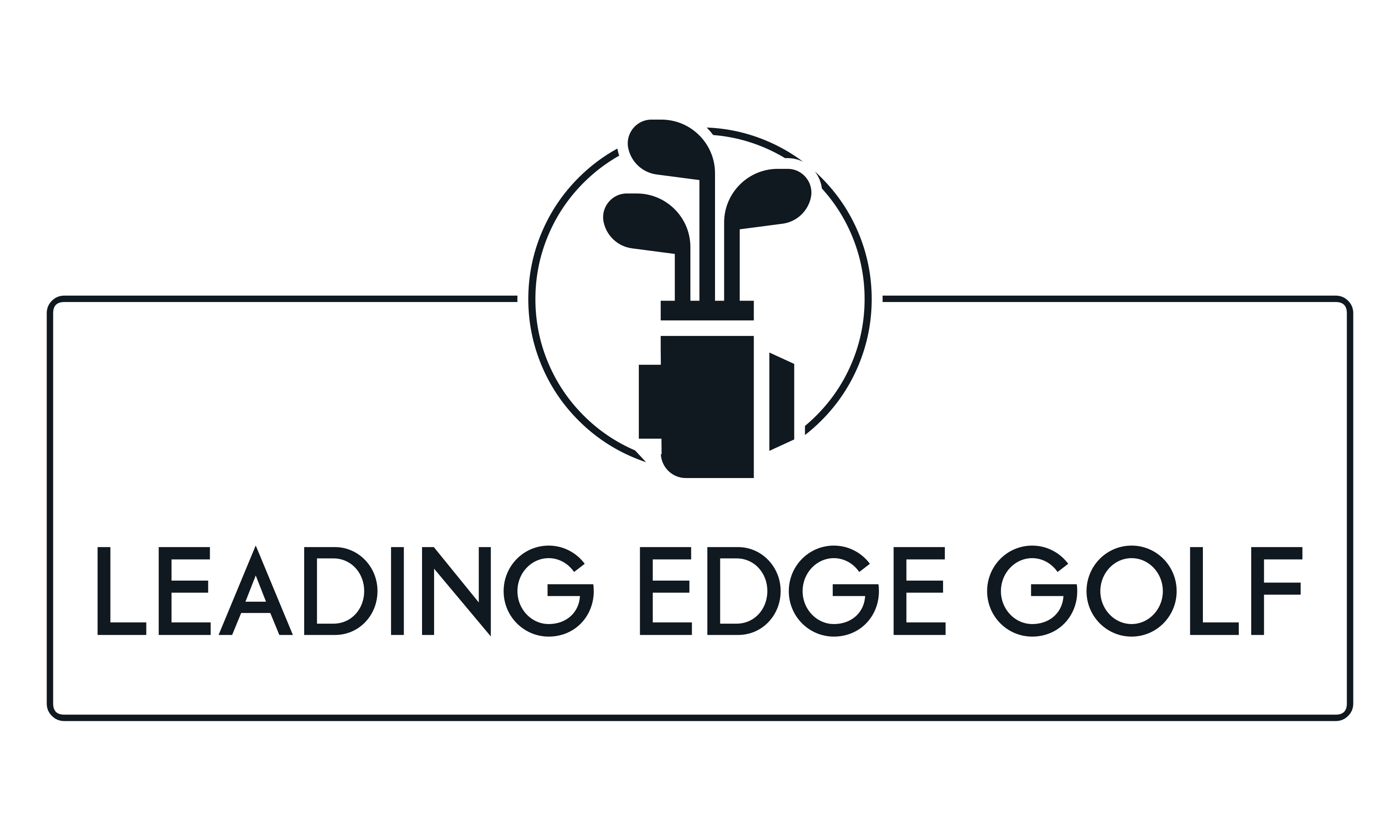An Overview of Club Fitting
What can we do to affect Accuracy, Distance, Trajectory, Backspin, and Feel?
Can a Golfer buy a better game?
The following items are all considered during a fitting session. Each one has an impact, some greater than others. Possibly the most important part of any fitting process is the interview. The players own thoughts will help determine the specifications of the club.
(Click on a Topic below to Read More)
LENGTH
Major factor on distance, accuracy and feel. Posture and swing plane. Centreness of impact. Use height and wrist to floor dimensions to determine initial club length. Use clubs of varying length, combined with face impact tape or powder to determine optimum length. This is necessary due to variances in skill level and swing styles.
LIE ANGLE
Major factor on accuracy in mid and short irons. Major factor on posture and swing path. Allows golfer to adopt proper athletic set up position. Proper length and lie are your spine’s friend. Be aware that proper lie fitting goes beyond simply having sole impact tape centred. Ball flight always trumps lie angle. The better a golfer you are fitting the more difficult lie fitting becomes due to the ability to manipulate the club.
SET MAKE UP
Major factor on distance, accuracy, trajectory, backspin, feel and overall scoring potential. Traditional set make ups or manufacturer set make ups don’t fit everyone. Besides having individual clubs fit to your specs, set make up is the easiest way to improve a player’s score.
SHAFT FLEX AND TORQUE
Major factor on feel. Medium on distance and accuracy. Helps keep proper tempo and encourage proper release (see Misconceptions). As a general guideline we will use the stiffest shaft that produces the desired trajectory, spin and feel.
FACE ANGLE/OFFSET ON WOODS
Major factor on accuracy. Relates to sidespin. Can help mitigate slices and hooks. Very overlooked specification due to the golfing publics’ infatuation with shafts. Face angle is one of golf’s great illusions. It is easy to be fooled by face angle perception when the driver is in the address position. A club that looks square may in fact be open when measured in a face angle jig. A club that looks a couple of degrees closed will probably measure square. This perception has become harder to overcome as driver heads have increased in volume. Clever use of paint lines is common to combat this phenomenon.
LOFT
Major Factor on distance, backspin and accuracy. Relates to launch angle and backspin. Relates to individual clubs as well as across the set to produce consistent yardage gaps.
SHAFT WEIGHT
Major factor in feel and distance. As graphite shafts become more economical there will be a major shift towards graphite shafted irons. My reasoning here is that graphite shaft makers now have the materials and knowledge to control bend point, flex, torque, balance point and total weight far better than the traditional steel shaft. This shift to graphite shafts in irons will include all player types including the low handicap players.
TOTAL WEIGHT
Feel and distance. Maintaining proper swing path.
GRIP SIZE
Large impact on feel and medium on accuracy.
SWING WEIGHT
Major feel issue. Medium distance and accuracy issue. Relates to club balance allowing the golfer to feel the position of the club head throughout the swing.
CENTRE OF GRAVITY
Major impact on launch, trajectory and ability to square the clubface at impact. Don’t forget that the line the energy travels along (the shaft) is always seeking to align itself with the centre of gravity of the club head. This is what ultimately makes larger club heads more forgiving and why dynamic lie fitting (irons) is paramount. This law of physics is the foundation of golf club design.
Advanced Club Fitting Topics
BALL SPEED
Measures actual initial launch velocity of golf ball. This information is required to determine proper shaft selection. From ball speed a proper flex range can be determined. This device makes it very simple to test various shafts, heads and club lengths to determine changes in ball velocity. No increase in velocity no increase in distance (Provided launch and spin are optimal).
LAUNCH ANGLE
Measures actual launch angle from the horizontal. This information is critical in determining the proper loft of driver for the golfer. Aside from ball velocity loft provides the best chance of improving distance. There is no one perfect launch angle. The perfect launch angle is determined from ball velocity, angle of attack and spin rates.
BACKSPIN
Measures actual backspin of ball during launch. Excellent information used to fine tune driver loft, shaft flex, shaft torque, bend point and tip stiffness. As you can imagine backspin is directly related to velocity and angle of attack. The higher the velocity the greater the need for an upward angle of attack to prevent excessive spin and ballooning ball flight. Conversely the lower the velocity the greater the need for spin to keep the ball airborne and the less critical the need for an upward angle of attack. There is no one optimal amount of backspin.
SIDESPIN
Measures off axis spin orientation. Provides an indication of face angle of driver at impact. Open face, slice spin closed face, hook spin.
PUSH/PULL ANGLE
Measures launch axis of golf ball in relation to chosen target. Radar based monitors track the motion of the clubhead. This provides clubhead path data that is valuable for both fitting and instruction.
CLUB SPEED
Radar based ball flight monitors also provide reasonably accurate club speeds as they track the club throughout the swing.
ANGLE OF ATTACK
As the club head is being tracked this type of monitor provides valuable information on the angle of attack of a player’s club head. If the monitor is properly positioned in relation to the player’s position the monitor will record not only angular attack in degrees positive for upward and negative for downward but will also show the fitter/instructor the position of the low point in the swing.
PUTTER FITTING
Often overlooked and always a problem if incorrect.
Getting the proper length, lie and style of putter should be the goal of all players. This club is used for a high percentage of your shots. Unless you hole out from off the green it is the only club used on every hole during your round. Having the putter correctly sized with a simple lie and length change can be very helpful to a difficult part of the game.
Advanced putter fitting using motion analysis can lead to further refinements in both technique and putter specifications. A simple example would be a player that consistently over rotates the putter face through impact. Using one of the adjustable weight putters we can add weight to the toe to slow down the tendency to shut the face.
Some Popular Misconceptions
SHAFTS
Most people believe that a shaft that is too soft bends backwards at impact. This is actually not possible. The reason being as the wrists release the shaft accelerates and the arms slow down. The shaft bends forward. This is the reason that softer shafts fly higher than stiffer shafts. Remember the force line (the line the energy travels along) has its source at the grip end of the club. Given sufficient energy (club speed) the grip end of the club and the centre of gravity of the club head will be on the same line. This means the head will always be ahead of the shaft at release.
People also believe that the shaft is the engine of the club. Forget it; the shaft is an inanimate object. The golfer is the engine; the shaft merely transfers the energy.
One thing we hear all the time is the shaft is all that matters. Just get me the right shaft and my club will work correctly. Well we have news for the average golfer, they could have a shaft that matches their DNA but if the head is the wrong loft or has poorly matched centre of gravity they are out of luck. A good example would be a golfer wanting to reshaft an 8 degree driver. So we check their swing out on the launch monitor. Launch angle is 6 degrees and ball speed is 110 mph. It matters little what kind of shaft you put in that 8 degree driver it will never work for that golfer. In this case as in most cases the club head is more important than the shaft. Loft, face angle and centre of gravity will almost always take precedence over the characteristics of the shaft. Also it is wise to bear in mind that no major manufacturer would deliberately put an ill-suited shaft in their golf clubs.
People also believe that shafts have a major influence on the dispersion of the golfer’s shots. We don’t know how many times we have heard that a shaft is too soft or has too much torque and is causing me to slice or hook. The shaft does have an effect on face angle. The more forward bend in the shaft through impact the more the face angle of the club closes. In reality the path, angle of attack and face angle through the hitting zone are the culprits. The shaft cannot correct path, angle of attack or manipulation of face angle. We have watched Jason Zuback hit numerous drives long and straight with a club called the “The Whippy Tempo Master” that has a flex akin to overcooked spaghetti. If the shaft were responsible for straightness this would be impossible. The shaft is more responsible for trajectory and energy transfer. Your local teaching professional can impact your dispersion factor far more than a golf shaft.
Another point to consider when looking at or testing shafts is do not automatically believe the manufacturers’ published flex for any given shaft. They all have different criteria that determine shafts stiffness. This is not to say that they are inconsistent. In fact the opposite is true. The modern golf shaft is very consistent, within one manufacturer’s shafts.
This is not to say that the proper balance of flex, torque and weight in a shaft that matches golf clubs that are properly fit for all other parameters will not make a difference. It definitely will, but it is not the only or the most important part of the club. The shaft is the single fitting parameter that becomes more important as the player becomes more advanced. The reason for this is the more advanced player can “feel” what the shaft is doing. Sadly it is often the less skilled golfers who seek answers in exotic shafts.
MOI (Moment of Inertia)
Having a high MOI (Moment of Inertia) club will help you square the club through impact. Wrong, MOI limits twist generated from off centre impacts. If the club face is not pointed at the target at impact a high MOI club will not make the face align with the intended target. It will simply reduce the twist of the club head due to the off centre impact. If the club is pointing left or right it will remain in that alignment. Again your local teaching professional can impact your face alignment far more than MOI. Is high MOI a bad thing? Definitely not. If it were the governing bodies would not be regulating MOI. However, remember this, MOI has zero impact on shots hit on the sweet spot.
Having equipment that best suits you can have a dramatic effect on your enjoyment of the game of golf.
This together with proper golf instruction and keeping physically active and fit is the only way to buy a better golf game.

